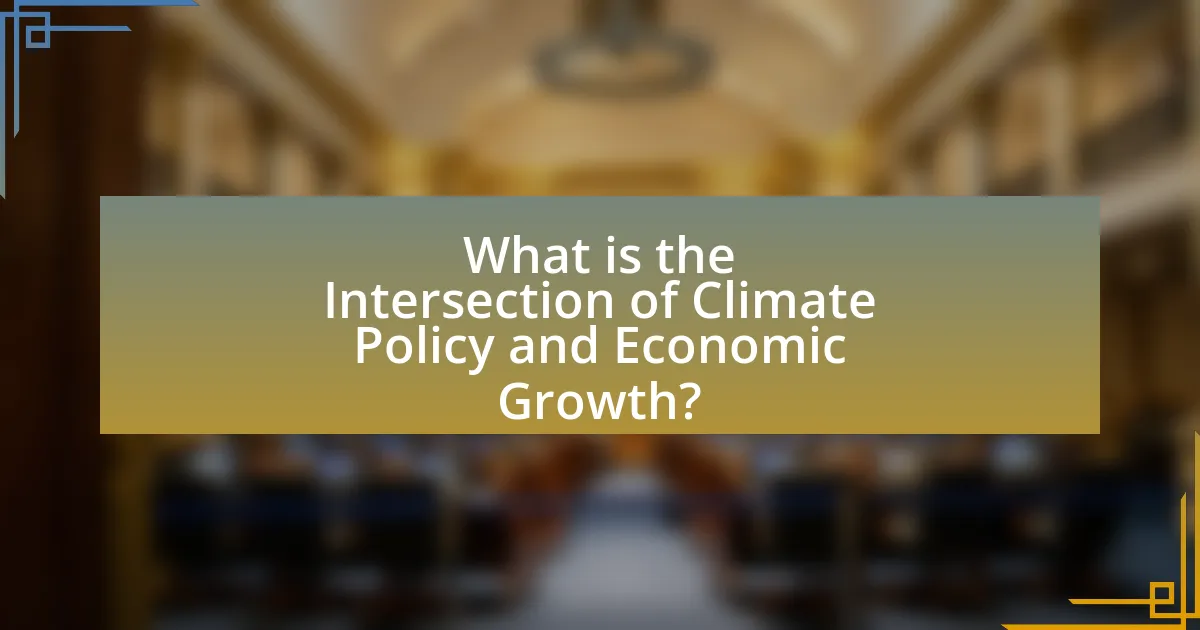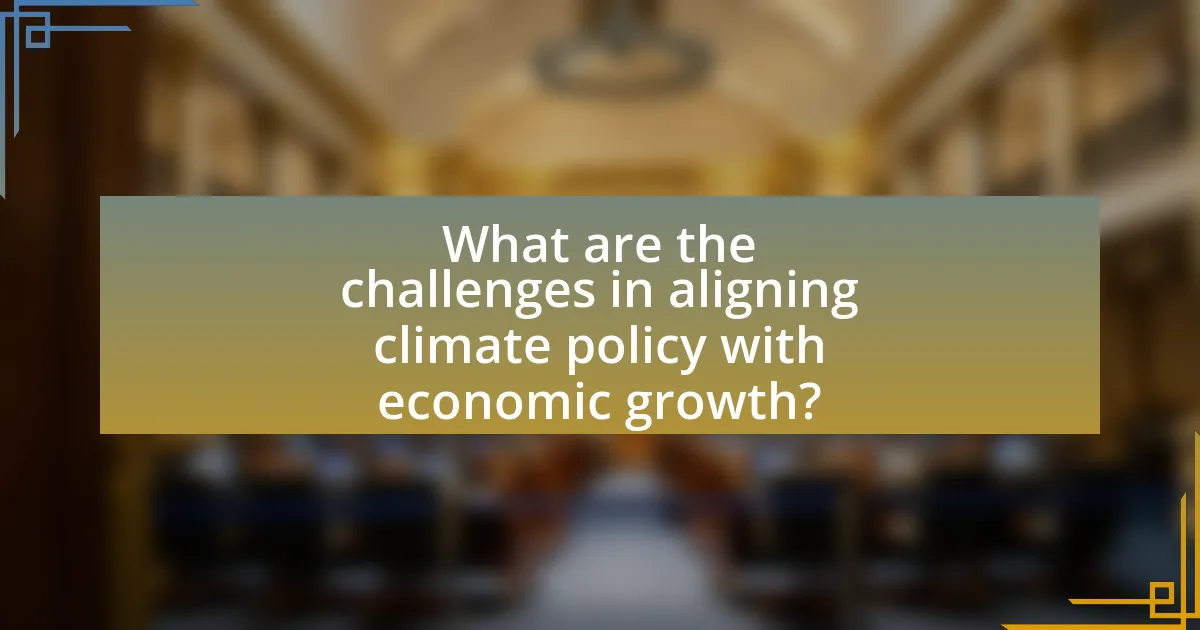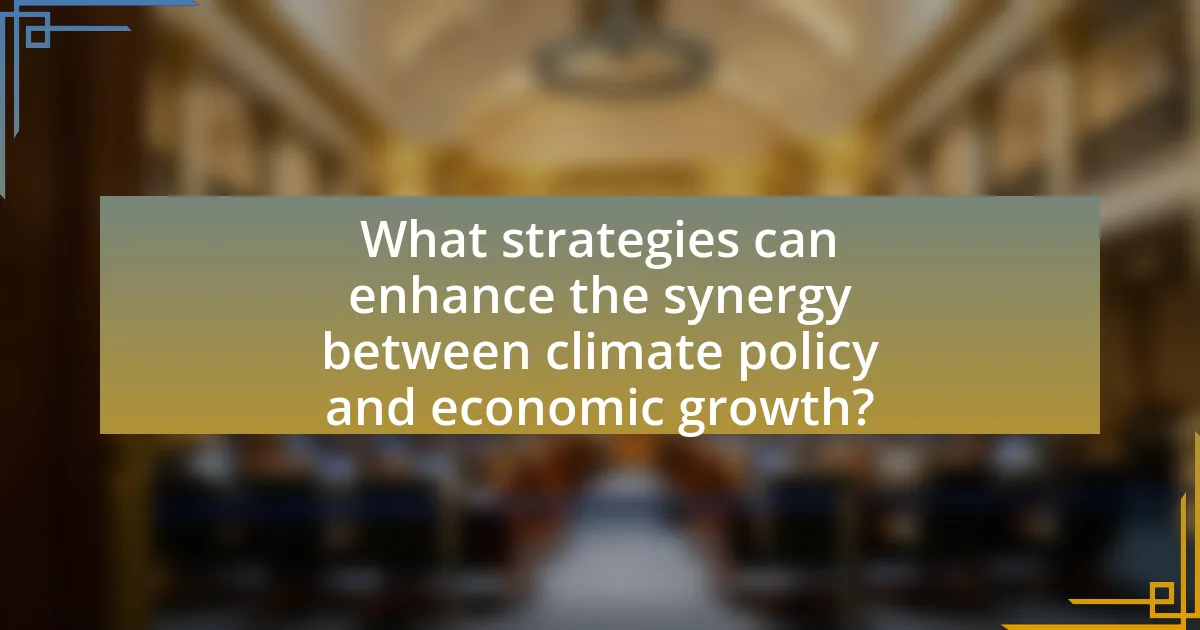The article examines the intersection of climate policy and economic growth, highlighting how environmental regulations aimed at reducing carbon emissions can stimulate economic performance. It discusses the key components of climate policy, such as emissions reduction targets and financial mechanisms, and their impact on job creation and innovation in green technologies. The article also addresses the importance of integrating climate policy with economic strategies to foster resilience and long-term prosperity, while outlining the challenges and opportunities faced by various economic sectors. Additionally, it explores how different countries approach this relationship and the role of governments and businesses in facilitating sustainable economic practices.

What is the Intersection of Climate Policy and Economic Growth?
The intersection of climate policy and economic growth refers to the relationship between environmental regulations aimed at reducing carbon emissions and the economic performance of a country. Effective climate policies can stimulate economic growth by fostering innovation in green technologies, creating jobs in renewable energy sectors, and improving public health through reduced pollution. For instance, a report by the International Renewable Energy Agency (IRENA) indicates that transitioning to renewable energy could create 24 million jobs globally by 2030, demonstrating that climate action can drive economic opportunities. Additionally, countries that invest in sustainable infrastructure often experience long-term economic benefits, as seen in Germany’s Energiewende initiative, which has led to significant growth in its clean energy sector while reducing greenhouse gas emissions.
How do climate policies influence economic growth?
Climate policies influence economic growth by promoting sustainable practices that can lead to innovation and job creation in green technologies. For instance, investments in renewable energy sources, such as solar and wind, have been shown to create more jobs per unit of electricity generated compared to fossil fuels. According to a report by the International Renewable Energy Agency, the renewable energy sector employed over 11 million people globally in 2018, demonstrating a direct link between climate policies and employment growth. Furthermore, transitioning to a low-carbon economy can enhance energy efficiency, reduce costs for businesses, and stimulate economic activity, ultimately contributing to long-term economic resilience.
What are the key components of climate policy?
The key components of climate policy include emissions reduction targets, regulatory frameworks, financial mechanisms, and adaptation strategies. Emissions reduction targets set specific goals for decreasing greenhouse gas emissions, often aligned with international agreements like the Paris Agreement, which aims to limit global warming to well below 2 degrees Celsius. Regulatory frameworks establish the legal and institutional structures necessary for implementing climate actions, such as carbon pricing and renewable energy standards. Financial mechanisms, including subsidies, taxes, and investment incentives, facilitate the transition to a low-carbon economy by supporting clean energy technologies and infrastructure. Adaptation strategies focus on enhancing resilience to climate impacts, ensuring that communities can withstand and recover from climate-related disruptions. These components collectively aim to address climate change while promoting sustainable economic growth.
How do these components impact economic performance?
Climate policy components, such as carbon pricing, renewable energy investments, and regulatory frameworks, significantly impact economic performance by driving innovation, creating jobs, and enhancing energy efficiency. For instance, a study by the International Renewable Energy Agency found that transitioning to renewable energy could create 24 million jobs globally by 2030, demonstrating the potential for economic growth through sustainable practices. Additionally, implementing carbon pricing can incentivize businesses to reduce emissions, leading to more efficient resource allocation and long-term cost savings. Thus, these components not only address environmental concerns but also foster economic resilience and growth.
Why is the relationship between climate policy and economic growth important?
The relationship between climate policy and economic growth is important because effective climate policies can drive sustainable economic development while mitigating environmental risks. Research indicates that investments in renewable energy and energy efficiency not only reduce greenhouse gas emissions but also create jobs and stimulate economic activity. For instance, a report by the International Renewable Energy Agency (IRENA) shows that transitioning to renewable energy could create 24 million jobs globally by 2030, highlighting the potential for economic growth aligned with climate objectives. Thus, integrating climate policy with economic strategies is crucial for fostering resilience and long-term prosperity.
What are the potential risks of neglecting this relationship?
Neglecting the relationship between climate policy and economic growth poses significant risks, including increased environmental degradation and economic instability. When climate policies are overlooked, the resulting environmental damage can lead to severe consequences such as natural disasters, which have been shown to disrupt economic activities and increase costs for governments and businesses. For instance, the National Oceanic and Atmospheric Administration reported that in 2020, the U.S. faced 22 separate billion-dollar weather and climate disasters, highlighting the financial burden of neglecting climate considerations. Additionally, failing to implement effective climate policies can hinder long-term economic growth by exacerbating resource scarcity and increasing energy costs, as evidenced by studies indicating that countries investing in sustainable practices often experience more robust economic performance.
How can understanding this relationship guide future policies?
Understanding the relationship between climate policy and economic growth can guide future policies by ensuring that environmental sustainability is integrated into economic planning. This integration can lead to the development of green technologies and renewable energy sources, which have been shown to create jobs and stimulate economic growth. For instance, a report by the International Renewable Energy Agency (IRENA) indicates that transitioning to renewable energy could create 24 million jobs globally by 2030. By recognizing this relationship, policymakers can design strategies that promote both environmental goals and economic development, ultimately leading to sustainable growth.

What are the challenges in aligning climate policy with economic growth?
Aligning climate policy with economic growth presents significant challenges, primarily due to the potential trade-offs between environmental sustainability and short-term economic interests. Policymakers often face resistance from industries reliant on fossil fuels, which can hinder the transition to greener alternatives. For instance, the International Energy Agency reported that global fossil fuel subsidies reached $400 billion in 2020, illustrating the financial incentives that conflict with climate goals. Additionally, the need for substantial upfront investments in renewable energy infrastructure can deter economic growth in the short term, as seen in countries that have struggled to balance immediate economic needs with long-term sustainability objectives. These factors create a complex landscape where achieving both climate targets and economic growth requires careful navigation and innovative solutions.
What economic sectors are most affected by climate policies?
The economic sectors most affected by climate policies include energy, transportation, agriculture, and manufacturing. These sectors face significant changes due to regulations aimed at reducing greenhouse gas emissions and promoting sustainability. For instance, the energy sector is transitioning from fossil fuels to renewable sources, which impacts traditional energy companies and creates opportunities for renewable energy firms. The transportation sector is experiencing shifts towards electric vehicles and public transit initiatives, affecting automotive manufacturers and fuel suppliers. Agriculture is influenced by policies promoting sustainable practices and reducing emissions from livestock and fertilizers. Lastly, manufacturing is adapting to stricter emissions standards and resource efficiency requirements. These changes are supported by data indicating that investments in clean energy and sustainable practices can lead to economic growth, as seen in the International Renewable Energy Agency’s report showing that renewable energy jobs have increased significantly in recent years.
How do renewable energy initiatives impact traditional industries?
Renewable energy initiatives significantly impact traditional industries by driving a shift towards cleaner production methods and altering market dynamics. For instance, the coal industry has faced declining demand as renewable sources like wind and solar become more cost-effective, with the U.S. Energy Information Administration reporting that renewable energy accounted for 20% of electricity generation in 2020, up from 10% in 2010. This transition forces traditional industries to adapt by investing in cleaner technologies or risk obsolescence. Additionally, renewable energy initiatives often lead to regulatory changes that impose stricter emissions standards, compelling traditional industries to innovate or incur penalties.
What are the implications for job creation and loss?
The implications for job creation and loss in the context of climate policy and economic growth are significant and multifaceted. Transitioning to a green economy can lead to the creation of millions of jobs in renewable energy sectors, such as solar and wind, which are projected to grow substantially; for instance, the International Renewable Energy Agency reported that the renewable energy sector employed over 11 million people globally in 2018, with expectations for continued growth. Conversely, traditional fossil fuel industries may experience job losses as economies shift away from carbon-intensive practices; the U.S. Bureau of Labor Statistics indicated that jobs in coal mining have declined by over 50% since 2011 due to market changes and regulatory pressures. Therefore, while climate policy can stimulate job creation in emerging sectors, it also poses challenges for workers in declining industries, necessitating targeted workforce development and retraining programs to mitigate the impact of job loss.
How do different countries approach the intersection of climate policy and economic growth?
Different countries approach the intersection of climate policy and economic growth through varying strategies that balance environmental sustainability with economic development. For instance, Germany emphasizes renewable energy investments, aiming to transition to a low-carbon economy while maintaining industrial competitiveness, evidenced by its Energiewende policy, which has led to a significant increase in renewable energy sources contributing to over 40% of its electricity by 2020. In contrast, China focuses on rapid industrial growth while implementing strict emissions targets, as seen in its commitment to peak carbon emissions before 2030 and achieve carbon neutrality by 2060, which aligns with its economic expansion goals. The United States has fluctuated in its approach, with recent policies under the Biden administration prioritizing green infrastructure investments to stimulate job creation while addressing climate change, aiming for a 50-52% reduction in greenhouse gas emissions by 2030 compared to 2005 levels. These examples illustrate that countries tailor their climate policies to their unique economic contexts, reflecting a diverse range of approaches to achieving sustainable growth.
What lessons can be learned from successful case studies?
Successful case studies in the intersection of climate policy and economic growth demonstrate that integrating sustainable practices can lead to significant economic benefits. For instance, countries like Denmark have successfully transitioned to renewable energy sources, resulting in a 40% reduction in greenhouse gas emissions while simultaneously boosting their GDP by 60% from 1990 to 2018. This illustrates that proactive climate policies can stimulate innovation, create jobs in green sectors, and enhance energy security. Furthermore, case studies show that collaboration between government, businesses, and communities is essential for achieving these outcomes, as seen in California’s cap-and-trade program, which has generated over $3 billion in revenue while reducing emissions. These examples highlight the importance of strategic planning and investment in sustainable technologies to drive economic growth alongside environmental stewardship.
How do economic conditions influence climate policy effectiveness?
Economic conditions significantly influence climate policy effectiveness by determining the resources available for implementation and public support for such policies. When economic growth is strong, governments often have more financial capacity to invest in renewable energy, infrastructure, and technology that support climate initiatives. For instance, during periods of economic prosperity, countries like Germany have increased funding for renewable energy projects, leading to substantial reductions in carbon emissions. Conversely, during economic downturns, budget constraints can lead to reduced funding for climate initiatives, as seen in the aftermath of the 2008 financial crisis, where many countries scaled back their climate commitments due to fiscal pressures. Thus, the state of the economy directly impacts both the feasibility and public acceptance of climate policies, shaping their overall effectiveness.

What strategies can enhance the synergy between climate policy and economic growth?
Implementing carbon pricing mechanisms can enhance the synergy between climate policy and economic growth by creating financial incentives for businesses to reduce emissions. Countries that have adopted carbon pricing, such as Sweden, have seen a significant decrease in greenhouse gas emissions while maintaining strong economic growth, with a reported GDP increase of 78% since 1990 alongside a 27% reduction in emissions. Additionally, investing in renewable energy infrastructure not only supports climate goals but also stimulates job creation and economic development; for instance, the International Renewable Energy Agency reported that the renewable energy sector employed over 11 million people globally in 2018, showcasing the potential for economic benefits aligned with climate initiatives.
How can businesses adapt to climate policies for economic benefit?
Businesses can adapt to climate policies for economic benefit by integrating sustainable practices into their operations, which can lead to cost savings and new market opportunities. For instance, companies that invest in energy-efficient technologies can reduce operational costs; a study by the International Energy Agency found that energy efficiency measures can save businesses up to 30% on energy bills. Additionally, aligning with climate policies can enhance brand reputation and attract environmentally conscious consumers, as evidenced by a Nielsen report indicating that 66% of global consumers are willing to pay more for sustainable brands. By proactively engaging with climate regulations, businesses can also access government incentives and funding aimed at promoting green initiatives, further bolstering their economic position.
What innovative practices can companies adopt to align with climate goals?
Companies can adopt innovative practices such as implementing circular economy principles, utilizing renewable energy sources, and investing in carbon capture technologies to align with climate goals. For instance, the circular economy approach minimizes waste by reusing materials, which can reduce greenhouse gas emissions significantly; a study by the Ellen MacArthur Foundation estimates that transitioning to a circular economy could reduce global emissions by 39% by 2030. Additionally, companies can switch to renewable energy sources like solar or wind, which have seen a 70% decrease in costs over the past decade, making them more accessible and economically viable. Lastly, investing in carbon capture technologies can help companies offset their emissions; the Global CCS Institute reports that these technologies could capture up to 2.5 gigatons of CO2 annually by 2030, contributing to climate goals effectively.
How can investment in green technologies drive economic growth?
Investment in green technologies can drive economic growth by creating jobs, fostering innovation, and reducing energy costs. The transition to renewable energy sources and sustainable practices generates employment opportunities in manufacturing, installation, and maintenance of green technologies. For instance, the International Renewable Energy Agency reported that the renewable energy sector employed over 11 million people globally in 2018, a number that continues to rise as investments increase.
Moreover, investment in green technologies stimulates innovation by encouraging research and development in sustainable practices and products. This innovation can lead to new markets and industries, further contributing to economic expansion. A study by the Global Commission on the Economy and Climate found that bold climate action could deliver at least $26 trillion in economic benefits by 2030 through sustainable development.
Additionally, green technologies often lead to lower energy costs over time, as renewable energy sources like solar and wind become more cost-effective. The U.S. Energy Information Administration noted that the levelized cost of electricity from solar and wind has decreased significantly, making them competitive with traditional fossil fuels. This reduction in energy costs can enhance the profitability of businesses and increase disposable income for consumers, thereby stimulating economic growth.
What role do governments play in facilitating this synergy?
Governments play a crucial role in facilitating the synergy between climate policy and economic growth by implementing regulations, providing incentives, and fostering innovation. Through legislation, such as carbon pricing and renewable energy mandates, governments create a framework that encourages businesses to adopt sustainable practices. For instance, the European Union’s Green Deal aims to make Europe the first climate-neutral continent by 2050, which includes investments in green technologies that stimulate economic growth. Additionally, governments can offer tax credits and subsidies for renewable energy projects, which not only reduce greenhouse gas emissions but also create jobs in emerging industries. This dual focus on environmental sustainability and economic development demonstrates how effective government policies can align climate goals with economic objectives, ultimately leading to a more resilient and sustainable economy.
What policies can encourage sustainable economic practices?
Policies that can encourage sustainable economic practices include carbon pricing, renewable energy incentives, and sustainable agriculture programs. Carbon pricing, such as cap-and-trade systems or carbon taxes, creates a financial incentive for businesses to reduce greenhouse gas emissions, leading to a decrease in pollution and a shift towards cleaner technologies. For instance, countries like Sweden have successfully implemented a carbon tax that has significantly reduced emissions while maintaining economic growth. Renewable energy incentives, such as tax credits and subsidies for solar and wind energy, promote investment in clean energy sources, which can create jobs and stimulate economic development. The U.S. solar industry, for example, has grown rapidly due to federal and state incentives, resulting in thousands of new jobs. Sustainable agriculture programs that support organic farming and conservation practices can enhance food security and protect ecosystems, contributing to long-term economic resilience. Research from the Food and Agriculture Organization indicates that sustainable agricultural practices can increase productivity and profitability while reducing environmental impact.
How can public-private partnerships enhance climate initiatives?
Public-private partnerships can enhance climate initiatives by leveraging resources, expertise, and innovation from both sectors to implement sustainable practices effectively. These collaborations enable the pooling of financial investments and technological advancements, which are crucial for developing renewable energy projects and improving infrastructure resilience. For instance, the Global Infrastructure Facility has demonstrated that such partnerships can mobilize billions in funding for climate-related projects, thereby accelerating the transition to a low-carbon economy. Additionally, successful examples like the partnership between the City of Los Angeles and private firms in the Clean Tech sector illustrate how shared goals can lead to significant reductions in greenhouse gas emissions while fostering economic growth.
What are the best practices for integrating climate policy into economic planning?
The best practices for integrating climate policy into economic planning include aligning economic incentives with sustainability goals, incorporating climate risk assessments into financial decision-making, and fostering stakeholder engagement. Aligning economic incentives ensures that businesses and consumers are motivated to adopt environmentally friendly practices, as seen in carbon pricing mechanisms that have successfully reduced emissions in various regions. Incorporating climate risk assessments allows policymakers to identify vulnerabilities and adapt strategies accordingly, which is crucial given that the World Economic Forum has identified climate change as a top global risk. Fostering stakeholder engagement ensures that diverse perspectives are considered, leading to more comprehensive and effective policies, as demonstrated by successful initiatives in countries like Sweden, where public participation has enhanced policy acceptance and implementation.


